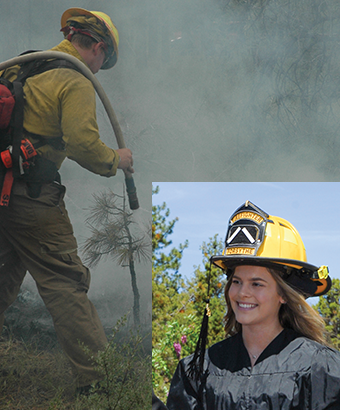Where There’s Smoke
As the heavy curtains of smoke drew tight across Central Oregon's late summer skies, Paula Simone knew her students would be out there, digging in against the state's fast-roiling fires. 2020 would become an historic fire season for Oregon, the second largest on record, scorching some 1.2 million acres and blazing a stark — and deadly — mosaic across the state.
"We have 167 active Structure Fire students right now, and all of them were involved in fire season," says Simone, COCC Fire Science professor and department chair. "Lionshead for sure…a lot of them went to Holiday Farm. Our folks are out there every day." Other College programs, like Forestry and Nursing, saw students deploy to the fires as well. Faculty went, too — every instructor in the Paramedicine program, for instance, is a career firefighter.
While many students and staff don hardhats and Nomex fire gear each summer, COCC's Bend campus also serves as the instructional center for the East Slope Training Area, part of a larger federal fire-training network. Regional offices of the U.S. Forest Service and Bureau of Land Management, from as far away as Burns and John Day, send their personnel for the multi-day sessions, coordinated by the College and taught by federal employees.
"We have 167 active Structure Fire students right now, and all of them were involved in fire season."
"It's all national standard material that we're teaching," says Jeff Priest, fire operations specialist for the Ochoco National Forest. A former COCC student, Priest now designs and helps teach the curriculum, providing qualifications in things like "Basic Air Operations" and "Wildland Fire in the Urban Interface." He runs military-style tactical simulations on plywood-sheet tables — kitty litter for soil, yarn for roads — to help tomorrow's division supervisors and incident commanders hone their decision-making. "I'm a ‘sim' guy for the region," he says.
The training arrangement grew from the College's Wildland Fire program, which several years ago consolidated into a general Fire Science degree. "The program started in ‘89 or ‘90," says Simone. "It was just a few classes for the Forest Service." Today, it provides instruction for hundreds of fire professionals each year.
Fighting wildfire is a narrative shared by many staffers at COCC. Simone herself was a crew boss and later a fire lookout. Past vice president Matt McCoy is a former smokejumper and hotshot. Instructional dean Michael Fisher saw the Yellowstone fires of '88 from behind the handle of a Pulaski. Season by season, forest by forest, flames may define the horizon — but there are those who stand the line.
For more information contact publicrelations@cocc.edu.

